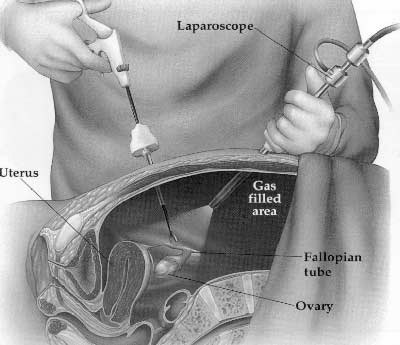Laparoscopy is a procedure to look inside your abdomen by using a laparoscope. A laparoscope is like a thin telescope with a light source. It is used to light up and magnify the structures inside the abdomen. A laparoscope is passed into the abdomen through a small incision (cut) in the skin. A camera is attached to the end of the telescope and the image is viewed on a video monitor. Surgery is carried out while looking at this monitor.

Diagnostic Laparoscopy
A laparoscopy may be done to find the cause of symptoms such as abdominal pain, pelvic pain, or swelling of the abdomen or pelvic region. Or, it may be done if a previous test such as an x-ray or scan has identified a problem within the abdomen or pelvis. A laparoscopy enables a doctor to see clearly inside your abdomen. Some common conditions which can be seen by laparoscopy include endometriosis ,other causes for infertility,pelvic inflammatory disease ,ectopic pregnancy,ovarian cysts ,appendicitis
What is laparoscopic surgery?
In addition to simply looking inside, a doctor can use fine instruments which are also passed into the abdomen through another small incision in the skin. These fine instruments are used to cut, trim, biopsy, grab, etc, inside the abdomen. This laparoscopic surgery is sometimes called 'key-hole surgery' or 'minimal invasive surgery'. Laparoscopic surgery can be used for various procedures which include:
-
removal of patches of endometriosis, fibroids
-
female sterilisation.
-
ovarian drilling for PCOD
-
treating ectopic [tubal] pregnancy.
-
taking a biopsy [small sample] of various structures inside the abdomen which can be looked at under the microscope and/or tested in other ways.
-
removal of the uterus - hysterectomy
-
inspection of the uterus, tubes and ovaries in cases of infertility as well as testing of the patency of the tubes
-
removal of the gallbladder. This is sometimes called a laparoscopic cholecystectomy . It is now the most common way for a gallbladder to be removed.
-
removal of the appendix.
-
removal of parts of the intestines.
In general, compared to traditional surgery, with laparoscopic surgery there is usually:
-
less pain following the procedure.
-
a shorter hospital stay.
-
a quicker recovery.
-
a much smaller scar.
Procedure
Laparoscopy and laparoscopic surgery are usually done whilst you are asleep under general anaesthesia. The skin over the abdomen is cleaned. The surgeon or gynaecologist then makes a small incision (cut) about 1-2cm long near to the navel (belly button). Some gas is injected through the cut to slightly 'blow out' the abdominal wall. This makes it easier to see the internal organs with the laparoscope which is gently pushed through the incision into the abdominal cavity. The surgeon or gynaecologist then looks down the laparoscope or looks at pictures on a TV monitor connected to the laparoscope.
This is a typical high flow CO2 insufflator which is used to maintain a continuous pressure inside your abdominal cavity so as to allow your surgeon to operate comfortably.

If you have a surgical procedure, one or more separate small incisions are made in the abdominal skin. These allow thin instruments to be pushed into the abdominal cavity. The surgeon or gynaecologist can see the ends of these instruments with the laparoscope and so can perform the required procedure.
When the surgeon or gynaecologist has finished, the laparoscope and other instruments are removed. The incisions are stitched and dressings are applied.

Besides the telescopes, camera, monitor etc we need a number of equipments such as harmonic scalpel ,morcellator,insufflators and monitors which are extremely important as the anaesthesia used is general anaesthesia and we pump in carbon dioxide - the levels of which have to be strictly monitored.
TOTAL LAPAROSCOPIC HYSTERECTOMY
 |
 |
| The uterus can be seen clearly for its size ,adhesions ,ovaries , tubes etc |
The fundal structures are taken up first and harmonic scalpel is used to transect them. |
 |
 |
| The uterine vessels are taken up next after dissecting the U V fold of peritoneum. | The uterine vessels are completely transected and vagina is visible and prominent both anteriorly and posteriorly. |
 |
 |
| The vaginal vault is sutured from the angle on one side by delayed absorbable sutures. | The sutures are taken upto the other side to maintain proper haemostasis. |
Possible complications from a laparoscopy.
There may be some minor bleeding or bruising around the skin incisions. Otherwise, in most cases a laparoscopy to just 'look inside' goes without any problem. Possible problems which may occur include the following.
- Accidental damage to structures inside the abdomen such as the intestines or certain blood vessels. This is rare, but if it occurs an emergency traditional operation may be needed to correct the damage.
- As with any operation, there is a small risk of complications of anesthesia.
- Bleeding and infections do occur occasionally as with the corresponding open surgeries.
- Occasionally, the incision becomes infected which may require a course of antibiotics.